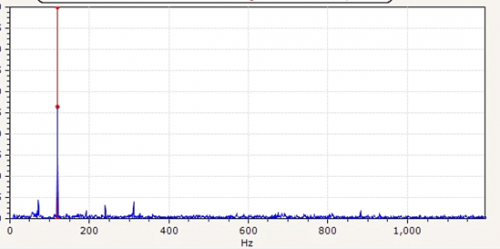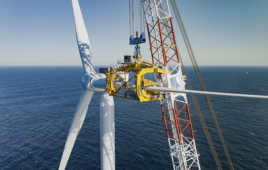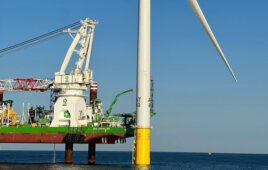By David Clark, CMS Wind
About 50% of drivetrain failures are in the generator, and they are predictable by months with the right detection. The failures are grouped into three specific categories: bearing-related, electrical-related and misalignments. Here we’ll discuss electrical fluting caused by an “ELF.”
Stray electrical current is not a problem unique to wind. It happens in several applications from processor chip manufacturing clean rooms to paper mills. This is particularly an issue in variable frequency drives (VFDs) where speed and load vary — similar to wind. The common approaches used to deal with stray currents are shaft-grounding-related. The range of shaft grounding fixes is vast, from manufactured aftermarket parts to home engineered solutions. Some fixes are as simple as laying a grounded braided flat copper wire strand over the shaft.
Some wind turbine OEMs have a shaft-ground installed or offer it as a retrofit. Grounding the generator-shaft grounds the stray electrical current. This however is not the root cause issue of the electrical line frequency (ELF) currents. One can mask the root cause of stray current with commercially available hardware like ring grounding, shaft-riding grounding, brush grounding and ceramic bearings.
Grounding is a bandage, because there should not be stray currents trying to ground themselves through a bearing to the generator shaft in the first place. Something is causing this, be it a cracked rotor bar or a loose wedge or a dozen other possible reasons. It’s best to know specifically what is causing the stray current and on which wind towers. It doesn’t make sense to blindly install shaft grounding on 100 towers or install ceramic bearings in a fleet if that doesn’t fix the root cause. A $20 copper wire shaft-ground and a $6,000 ceramic bearing upgrade will both work to mask the ELF.

How vibration sees electrical line frequency (ELF). This failure mode is not seen in SCADA data or temperature and is a significant contributor to generator failures.
Vibration condition monitoring systems (CMS) measure specific vibration frequencies and vibration severity that can indicate the presence of stray electrical currents. The frequency shows in correctly configured vibration condition monitoring at a very specific frequency. This electrical issue in vibration is known as electrical line frequency (ELF).
There is a common assumption that any CMS unit has the proper sensor, correct measurement type, measurement configuration and proper analysis, but the variables are astounding if the CMS is not set up correctly. If everything is set up properly, detection is elementary.

As ELF progresses, the bearing starts to fail through a process known as electrical fluting. Vibration detects early bearing defects from electrical fluting. Shown above as bearing defect peaks.
The beauty of correctly configured CMS is that it is specific in detection. For example, instead of testing every wind turbine on a 100-tower site for ELF, CMS detects only the few that have this issue. From there, those few outliers should be further tested as to the root cause of the ELF. Using electrical specific testing, can help pinpoint the ELF source.
ELF destroys a generator through electrical fluting. As the stray electrical current tries to find the path to ground, it tries to ground through the bearing. When this happens, the current attempts to arc-weld itself as the current jumps from the different bearing components. And it creates a distinctive pattern of failure visible on the inner and outer races. Vibration analysis sees not only the ELF but also the resulting electrical fluting pattern.

Electrical fluting on a bearing. This creates a very specific wear pattern and very predictable vibration signature months ahead of a failure.
You can avoid ELF issues through acceptance testing. For example, I have taken CMS data on a one-year-old windfarm with two different generator manufacturers installed in the OEM wind turbine. Every single Brand A generator had electrical issues and 100% of Brand B had zero. Brand A did not live to see the end of warranty. If these generators were tested prior to installation, I doubt they would have been installed. I have also seen other sites where ELF is not present whatsoever.
Typically, a correctly set up CMS will detect ELF with enough time to correct the grounding problem before it permanently damages the generator bearing. If not corrected, CMS will then monitor the impending failure with enough lead time (commonly six to seven months) to order the bearing replacement, repair up-tower and reduce significant downtime and production loss. Vibration condition monitoring identifies the presence and severity of the ELF months in advance.
This holiday season avoid this ELF.
Filed Under: Bearings, Components, Featured, Generators




